- Author: Kathy Keatley Garvey
They look like shiny blue and black needles.
Make that "flying" shiny blue and black needles.
We spotted this damselfly foraging on a Mexican sunflower (Tithonia) this week in our family bee garden. The blue was breathtaking.
Can anything be so blue? What species is this?
"By the amount of black on the middle abdominal segments, it looks to me like a male of Enallagma carunculatum Morse," said senior insect biosystematist Rosser W. Garrison, with the California Department of Food and Agricultur'es Plant Pest Diagnostics Branch.
Its common name is "tule bluet." It's a species of damselfly in the family Coenagrionidae, found throughout North America, according to Wikipedia. It's all over the United States, "except for the southeastern quarter."
Its blue and black abdomen is usually more black than blue. It derives its common name, "tule bluet," from the stands of tule it frequents. Its habitat includes rivers, lakes, ponds, marshes and bogs. It likes to hang out in the bulrushes.
The nymphs eat such aquatic insects as mosquito and mayfly larvae, while the adults feet on a wide variety of small flying insects, including mayflies, flies, small moths and mosquitoes. Sometimes they'll grab a few aphids from plants.
Our little buddy (along with other damselflies) was hanging out in our Tithonia patch.
But the Tithonia patch is just a few feet away from our fish pond...
Check out the images of tule bluet on BugGuide.net for more of a blue fix and more information!

- Author: Kathy Keatley Garvey
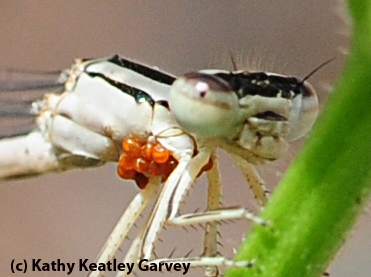
Naturalist Greg Karofelas of Davis, an associate of the Bohart Museum of Entomology, has not only seen them, he has photographed them. See his truly spectacular photo below.
The mites look like a cross between pomegranate kernels and salmon eggs. They are hitchhikers!
It's a good case of phoresy, or the symbiotic relationship in which one organism transports another organism of a different species.
Scenario: Say a damselfly is laying her eggs in a fish pond or the wetlands. Say some mites are waiting for her. They seek free meals and a free ride to the next pond to find mates and reproduce.
The damselfly dips down. They jump up.
What a load!
We wrote about these mites in a Bug Squad blog on July 25, 2013.
As for the image of the water mites that Greg Kareofelas captured, he suspects they may be Arrenurus mitoensis.
All we can say is "Wow!" Great image, Greg!
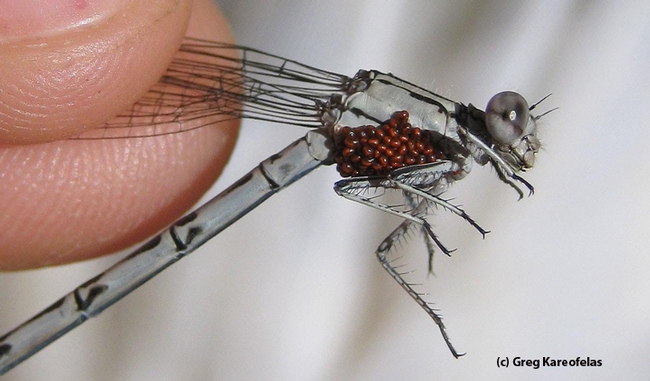
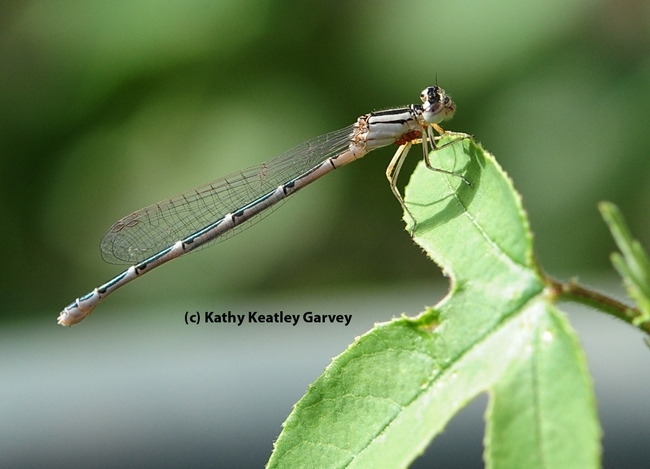
- Author: Kathy Keatley Garvey
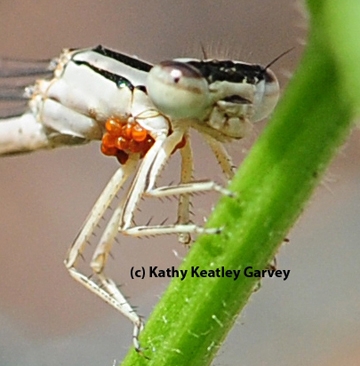
The result was a good one: more damselflies.
Damselflies lay their eggs in water, whether it be a pond, underwater vegetation, or in water-filled cavities in trees. If they lay their eggs in a fish pond, fish feast on the eggs and larvae.
But not this year, not in our pond. One egret. No fish. And now damselflies are no longer in distress.
On any given day, 20 to 25 damselflies flit around our bee garden, searching for food as they land on the stems of the Mexican sunflower (Tithonia), catmint (Nepata), and oregano (Origanum).
They also search for mates and occasionally collide with a bee or butterfly.
Most of the damselflies we see carry the parasitic water mites (Hydracarina), which look like red caviar.

Damselfles and dragonflies belong to the same order, Odonata. Damselflies, however, are typically much smaller than their dragonfly cousins. Wikipedia tells us that damselflies, suborder Zygoptera, can be distinguished from dragonflies "by the fact that the wings of most damselflies are held along, and parallel to, the body when at rest. Furthermore, the hindwing of the damselfly is essentially similar to the forewing, while the hindwing of the dragonfly broadens near the base.
We've never seen a damselfly eat anything or anything eat the damselfly, although our resident praying mantis seemed quite interested--or perturbed--when a damselfly bumped into him.
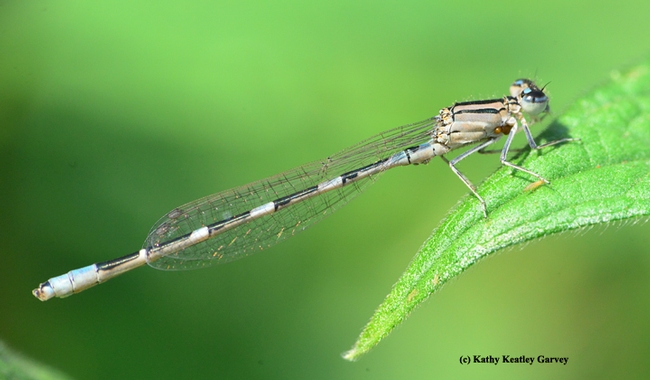
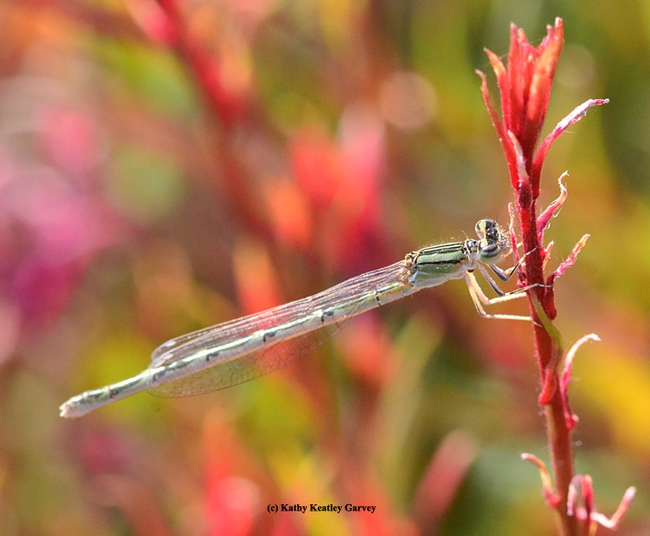
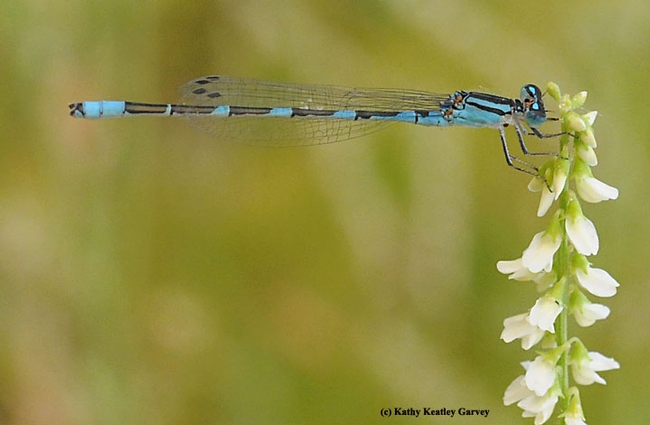
- Author: Kathy Keatley Garvey
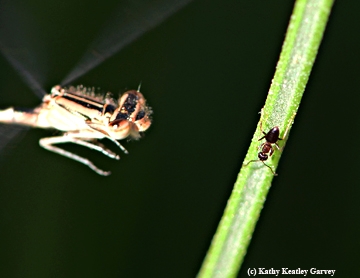
They're so tiny and inconspicuous that they're easy to miss. They're about an inch long and so slender that they look like flying needles.
Like its cousin, the dragonfly, the damselfly (suborder Zygoptera) is a predator that catches and eats flying insects. Flies, knats and mosquitoes are often on their menu.
Damselflies frequent the area near our fish pond and we see them glide in and out of our lavender patch, the catmint, oregano and the Mexican sunflowers (Tithonia). Sometimes they perch on a stem in the early morning and warm their flight muscles.
When we see them, we always look for bright red mites. Red mites? Think of a a cluster of miniature salmon eggs. Some of these damselflies are so heavily parasitized that you wonder how long they'll survive. Damsel in distress?
We've never seen a damselfly actually catch a flying insect, but we did find one last weekend that was quite interested in an ant scurrying down a lavender stem. The damselfly backed up and appeared to be targeting it.
The ant, however, escaped.


- Author: Kathy Keatley Garvey
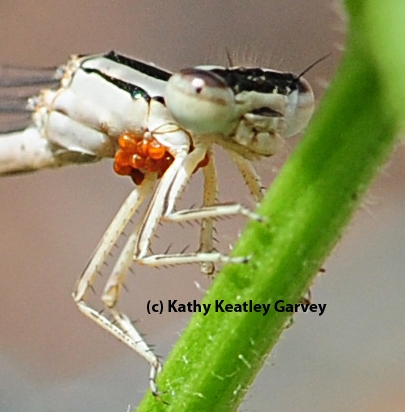
A pond attracts dragonflies and damselflies.
Last weekend, though, we spotted a damselfly a good 65 feet away from our pond. It touched down on our passion flower vine (Passiflora). Lights, camera, action...
The enlarged photo revealed a surprise: a cluster of something reddish-orange beneath the thorax.
Now that's something you don't see every day!
"Water mites," said native pollinator specialist Robbin Thorp, emeritus professor of entomology at UC Davis. (There are also images on BugGuide.net.)
"Phoresy," said entomology graduate student Lesle Saul-Gershenz, and professor Sharon Lawler, both of the UC Davis Department of Entomology and Nematology. Phoresy is a symbiotic relationship in which one organism transports another organism of a different species. Bottom line: these bright red mites, from the tick family, are hitchhikers that feed on body fluids. They jump off when the host drops down over a new pond or wetland.
What's the effect of water mites on damselflies? Surely, that parasitic load of arachnid hitchhikers must be cumbersome.
Scientists Jose Andres and Adolfo Cordero of the Universidade de Vigo, Pontevedra, Spain, took a close look at parasitism in their research “Effect of Water Mites on the Damselfly, Ceriagrion tenellum,” published in a 2002 edition of Ecological Entomology.
They pointed out:
1. "Water mite parasitism is expected to have an important effect on damselfly survivorship and reproductive success, because mites drain considerable amounts of body fluids from their hosts," they wrote in their abstract. "This study tests the effect of water mite parasitism in a marked population of the damselfly Ceriagrion tenellum during 1995 (individuals marked as mature adults) and 1996 (individuals marked as tenerals)."
2. "Almost all teneral individuals were parasitized (98%) and mites were aggregated strongly on some individuals. Parasite load increased during the season."
3. "Parasites had no effect on the probability of recapture of hosts as mature adults. The average daily survival rate of lightly- and heavily-parasitized individuals, estimated with Jolly's stochastic method, did not differ significantly."
4. "In 1995 parasites had a significant effect on host mating success. The probability of mating was about 25% lower for heavily parasitized males than for lightly parasitized males. Lightly parasitized males also mated more times than heavily parasitized males, even if heavily parasitized males lived longer. In 1996, parasitism did not have an effect on male mating success. In both years mites had no effect on female lifetime mating success."
In conclusion, they found that "water mite parasitism does not reduce damselfly survivorship, but it could reduce male mating success in some circumstances. Further long-term studies are needed, especially in populations with a lower incidence of parasitism."
As for our little damselfly, it lumbered away with its distinctive load of little red hitchhikers clinging to its thorax...



